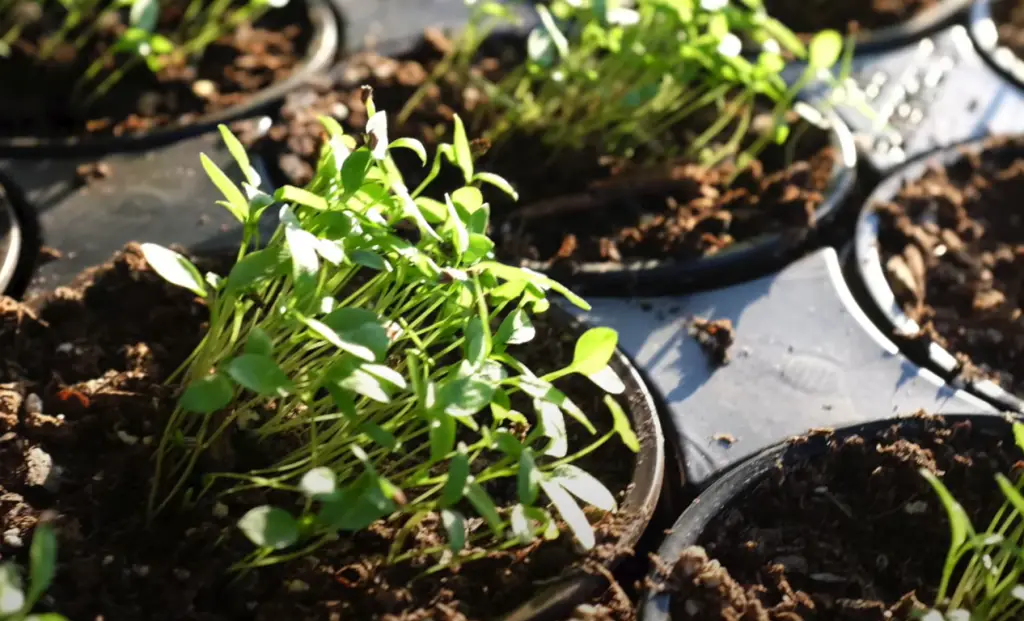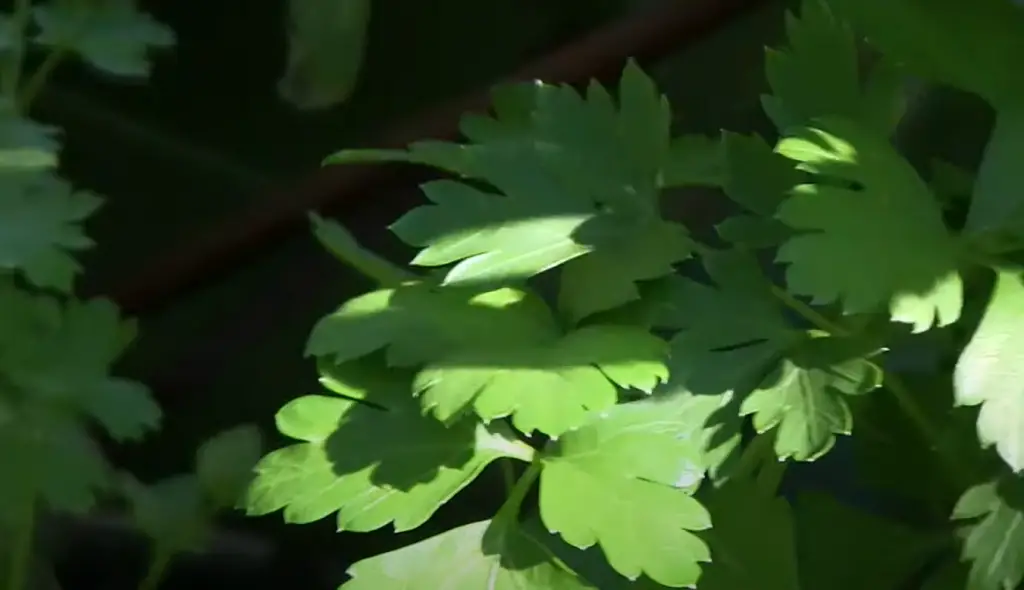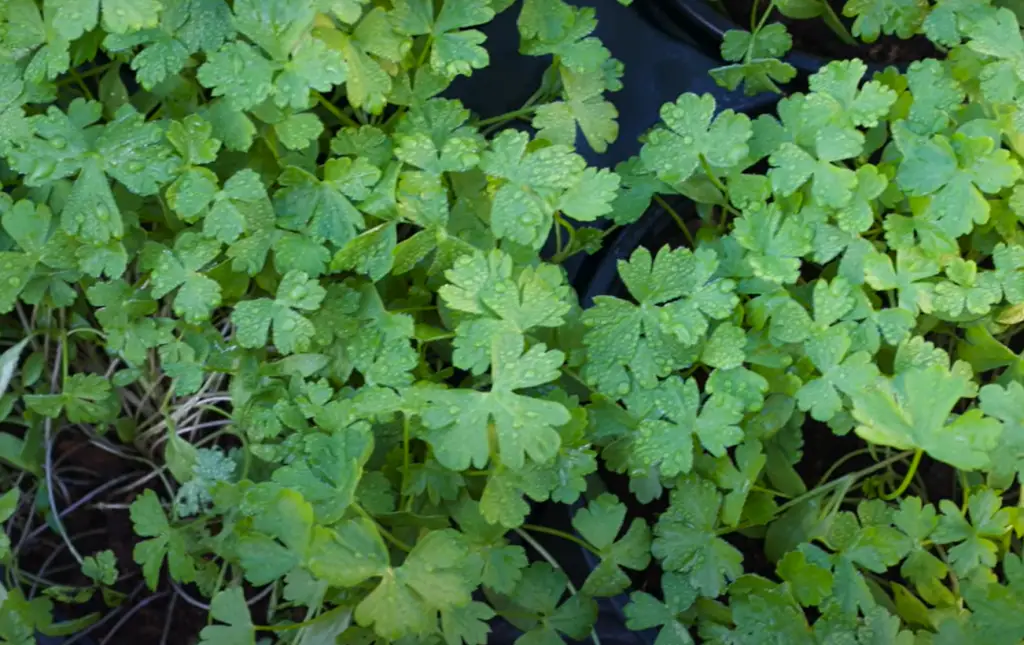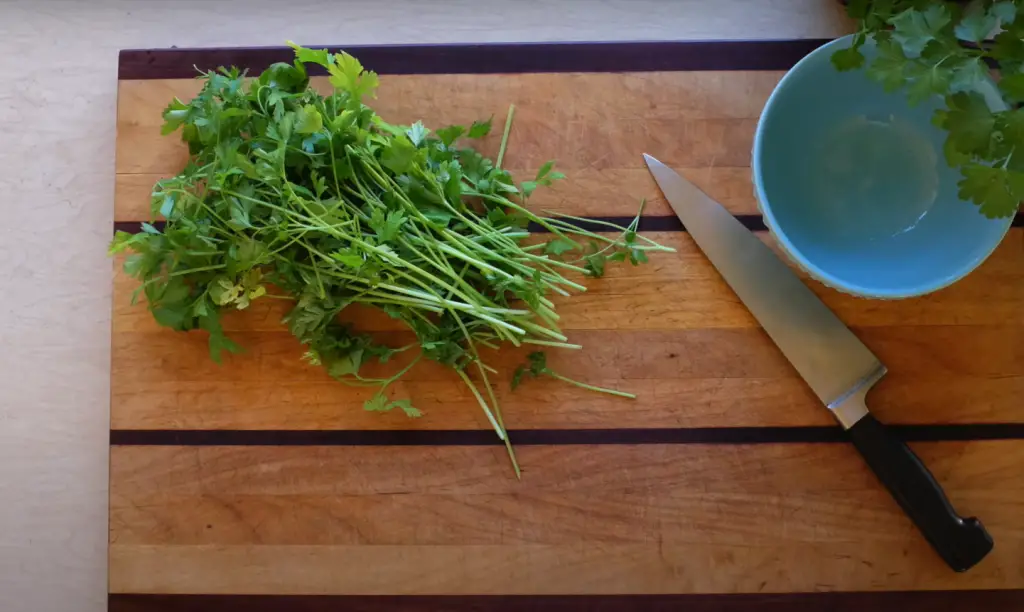Harvesting parsley doesn’t have to be a daunting task. In fact, with the right knowledge and approach, it’s possible to gather foliage from your plant without even harming its root system beneath! What’s more, as one of the best sources of vitamins A and C amongst all vegetables known to man, harvesting your own parsley is an excellent way to provide yourself with that extra boost in nutrition you may need.Join us on this incredible journey as we guide you through the art of harvesting parsley without harming the plant. Discover the secret to enjoying the freshness of herbs all year round!
How to Harvest Parsley?
Harvesting parsley is a simple process that can be completed without killing the plant. All you need to do is follow these steps:
- Wait until the leaves are mature and have developed their full flavor. This usually takes about three months from planting.
- Cut an outer stem with some leaves attached, leaving at least one leaf pair behind on the plant so it will continue to grow and produce new stems and leaves.
- Avoid harvesting more than two-thirds of any given plant in a single harvest session as this could damage or stress the plant; instead wait several weeks before harvesting again to give the parsley time to regrow.
- Rinse off excess dirt and remove any damaged leaves or stems before storing and using your harvested parsley.
- Parsley can be used fresh, dried, frozen, or as an extract for a range of culinary dishes, sauces, and dressings. Enjoy!

By following these steps you will be able to harvest parsley without killing the plant so that it may continue to provide delicious herbs for many harvests to come. [1]
How to Dry and Store Parsley?
Once you have harvested parsley, the next step is to dry and store it. You can air-dry the parsley on a screen or hang bunches of it upside down in a cool, dark place like your pantry. Be sure to spread out the leaves so that air can circulate around them.
When the leaves are crisp and crumbly, they’re ready to be stored.Store dried parsley in an airtight container away from direct sunlight and moisture. This will help maintain its flavor and color for up to six months. If you plan to use fresh parsley more often than dried, freeze it instead. Simply wash and chop the leaves before placing them in a freezer-safe bag. Parsley frozen this way will last up to one year. Harvesting and drying parsley is an easy way to enjoy its flavor all year round. Knowing how to properly harvest and store parsley will ensure you get the most out of your herb garden!
How to Harvest Parsley Seeds?
Parsley is an excellent addition to many dishes, but the seeds of this herb can be tricky to harvest. Fortunately, with a bit of knowledge and patience you can easily capture all the flavor of parsley in your cooking.
The first step to harvesting parsley seeds is to wait until they are mature – the plant will start to produce seed heads when it is about six months old. Once the seed heads have turned brown, it’s time to start gathering them up. To do so, gently rub each flower head between your fingers while holding it over a bowl or container – the small round green balls inside are your seeds!

Be careful not to rub too hard or you may damage them before they drop into the container. Once you have collected all the seeds, allow them to dry for several days before storing in an airtight container and keeping them in a cool, dark place. By following these steps, you can harvest parsley seeds without killing the plant or affecting its growth. The next time you want to add some flavor to your cooking, simply pop open your stash of freshly harvested parsley seeds!
Best Parsley Seeds For Home Gardens
Parsley is a great addition to any home garden. Growing parsley requires the right type of seeds for your climate and soil conditions, as well as harvesting methods that keep the plant alive. Here are some of the best parsley seed varieties to get you started:
Italian Flat Leaf Parsley: This variety has dark green leaves with a mild flavor and aroma. It’s perfect for adding flavor to salads, soups, and other dishes. The leaves also have many vitamins, minerals, and antioxidants that help improve overall health.
Tri-Color Parsley: This unique three-colored variety has bright green stems with white tips and yellow flowers. It gives dishes an attractive presentation while providing a hint of flavor. It’s also great for garnishes and can be used fresh or dried for later use. [2]
French Curly Parsley: This variety has finely cut leaves that are known for their strong aroma and taste. The leaves are often used as a garnish to give dishes an attractive presentation while adding flavor. It’s also commonly used in Middle Eastern recipes such as tabbouleh, hummus, and tzatziki sauce.
Harvesting parsley requires careful consideration when using the right methods to ensure you don’t kill the plant while harvesting its leaves. When harvesting parsley, it’s important to only take what you need from the plant since taking too much can stress the plant and cause it to wilt. Start by snipping off a few leaves from the bottom of each sprig, then work your way up the stem until you reach the foliage. Be sure to avoid taking any stems or flower buds since they contain essential nutrients for the plant’s growth. To ensure maximum health of your parsley plants, consider harvesting them every two weeks or so instead of all at once.
By using these tips, you can keep your parsley plants alive while still enjoying their fresh flavors in your home-cooked meals! So go ahead and get started on growing some delicious parsley with one of these top varieties today.
How Do You Know When Parsley Is Ready To Harvest?
Parsley is ready to harvest when it has developed a full, bright green color. The leaves should be full and crisp. You can also tell that the herb is ready for harvesting if the stem of the plant is thick and solid. When a parsley plant has reached its peak in growth, it will have at least 6-8 healthy leaves on each branch.

The best time to harvest parsley is in the morning after any dew or moisture has evaporated from the plants. This ensures that the leaves remain dry and free of any disease from excess moisture buildup. Additionally, fresh parsley tends to have better flavor than older leaves so try to harvest as close to its peak as possible for optimal taste. [3]
Why Is Your Parsley Bitter?
When harvesting parsley, it’s important to harvest the right way so as not to kill the plant. When parsley is harvested too soon or incorrectly, the leaves can become bitter and unpleasant tasting. This is because when a leaf is cut, the plant sends out an enzyme into the area of the cut stem that makes it difficult for cells in that area to take up water. The result is a bitter flavor in the remaining leaves.
Fortunately, there are several ways to avoid this bitterness and enjoy your fresh-picked parsley without any negative effects on your plants’ health.
First, only harvest what you need from each soil patch or pot of parsley – never take more than about one-third of any given plant. Additionally, make sure that you harvest the inner leaves instead of the outside ones; this will help prevent stems from becoming too exposed and promoting bitterness.
Finally, it’s important to avoid over-watering parsley! Too much water can cause roots to rot and lead to bitter-tasting leaves. To prevent this, stick to a schedule of watering only when needed, rather than drenching your plants on a regular basis. Allow the soil around your parsley plants to dry out a bit between waterings for best results.
Will Parsley Grow Back After Cutting?
Yes, parsley can grow back after cutting. For continuous harvesting of fresh parsley, you should harvest only the outer stems along with a few leaves at each picking. This way you will not cut off all the leaves and stems from the plant. Leaving some of the stem and leaf material intact helps to preserve the life of your plant by allowing it to continue growing until you are ready for another harvest. When harvesting parsley, always use sharp scissors or garden shears, as dull blades may damage or tear the delicate stems and leaves.
Be sure to take no more than a third of the total number of stems and leaves from any given plant so that it has enough foliage to photosynthesize effectively. Once these growth points have been removed, the plant will send out new stems and leaves in a matter of days, allowing for multiple harvests over time. In fact, if you keep harvesting periodically throughout the season, your parsley plant can continue to produce fresh foliage for several months!

Harvesting from multiple plants can also help to extend the harvest season. Planting different varieties of parsley with different maturation times allows you to stagger your harvests so that you have access to fresh foliage at all times. With proper care and regular harvesting cycles, there is no limit to how much parsley you can enjoy! [4]
How Often Should You Harvest Parsley?
When harvesting parsley, you should avoid cutting too much foliage from the plant at one time. Doing this can weaken the plant and stunt its growth. Aim to harvest no more than one-third of the foliage per session.
Ideally, parsley should be harvested slightly before it reaches full maturity as young leaves have a stronger flavor. Once you have harvested what’s necessary for your recipes, let the other leaves continue growing until they mature and can be harvested again in about two weeks. This way, you’ll get successive harvests and enjoy fresh parsley for longer!
To maximize yield and flavor, it is best to harvest parsley in the morning when the oils are most potent. However, be sure to avoid harvesting after a heatwave or lengthy dry spell as this can have a negative effect on flavor.
Finally, if your parsley plant has gone to flower, you may choose to let it bloom for its ornamental value. The flowers of some varieties can also be eaten raw or cooked in salads for added flavor. However, once flowering begins, the leaves will start to lose their flavor so try to pick them before bloom!
How Many Times Can You Harvest Parsley?
Parsley is an incredibly versatile herb that can be used in many dishes, from salads to soups. Thankfully, it’s also a resilient plant that can handle multiple harvests. You can cut the leaves of the parsley plant with scissors or garden clippers without damaging the root system as long as you follow some harvesting guidelines:
- Harvest only about 1/3 of the total leaves at one time.
- Cut off just above the existing stems so they don’t die off and encourage new growth.
- Clip away any yellowing or wilted leaves before harvesting to promote healthy growth for future harvests.
Harvesting parsley this way ensures that the plant will continue to regrow, and you can continue to harvest the leaves several times throughout the growing season. Not only is this a more sustainable way of harvesting parsley, but it’s also much easier and quicker than replanting completely each time. Additionally, this method allows for a larger yield since you can collect multiple harvests from one plant.

In general, parsley is able to be harvested up to three or four times per season with proper care. However, the number of harvests may vary depending on how well you take care of your plants and how quickly they are able to regrow after cutting back. With proper care and attention, you should be able to keep harvesting your healthy parsley plants until it’s time for them to go dormant in the winter. [5]
Does Parsley Come Back Every Year?
Parsley is a biennial, meaning that it grows and produces flowers and seeds in its second year before dying after flowering. In areas with mild winters, parsley may survive the winter as a perennial and come back each year. However, in colder climates, parsley will not be hardy enough to survive winter temperatures below freezing.
To ensure your parsley returns each season, you should try to protect it from cold temperatures by either mulching or covering it with soil or other material during bouts of cold weather. Additionally, you can propagate parsley through cuttings taken during the summer months so that you can have new plants for subsequent years. Parsley grown from seed usually does not come back every year but some varieties are bred to be more winter-hardy.
Can You Eat The Stems?
Yes, you can eat the stems of parsley! Stems are often used for decoration on dishes or in salads, but they’re also packed with flavor and nutrients. When harvesting parsley using the above method, make sure to twist off only a few ripe stems at a time so new ones can grow back. If you find that your parsley is growing too quickly and needs thinning out more frequently, cut more mature stems close to the base while leaving younger ones to develop fully. This will ensure that your plant keeps producing new leaves for harvesting. Remember to always use kitchen scissors instead of pulling off any leaves by hand as this could damage the plant. Additionally, when removing large amounts of parsley from one area of your plant, make sure not to pull the leaves off completely as this could uproot it.

Finally, when you’re finished harvesting parsley for the day, give your plant a quick spritz of water to help nourish its delicate leaves and stems. This way, it will continue to produce fresh foliage indefinitely!
Can You Eat Bolted Parsley?
Yes, you can definitely eat bolted parsley. In fact, many cooks prefer to use bolted parsley because of its mellow flavor and texture.
You can also mince the leaves finely for salads or sauces. Or you can quickly blanch them in boiling water before adding them to a dish for a milder flavor. Either way, don’t forget to add some freshly chopped parsley just before serving as well — that will give your dishes an extra burst of freshness! [6]FAQ
How do you pick parsley so it keeps growing?
Harvesting parsley correctly can help the plant keep growing for multiple years. To do this, clip off leaves that are at least two inches from the top of the stem. This will avoid cutting too deeply into the main stem and ensure that the leaves have enough energy to grow back. Also, be sure to leave some foliage on each stem so that the plant continues to photosynthesize. Additionally, don’t harvest more than one-third of a plant’s foliage at once as it may reduce its vigor and growth. If you need large amounts of parsley, consider dividing your plants or planting new ones in different areas. Finally, trim your parsley plants regularly throughout the season to promote bushier growth and prevent bolting (i.e. flowering).
What is the best way to store parsley?
Once you’ve harvested your parsley, it’s important to store it properly so that it retains its freshness and flavor. To do this, wrap the parsley in a damp paper towel and place it into an airtight container or resealable plastic bag. Place this in the refrigerator where it should stay fresh for up to one week. If you don’t have room in the refrigerator, try storing your parsley in a cool, dark place such as a cellar or basement and use it within two days of harvesting. Alternatively, if you want to keep your parsley for longer than one week, consider freezing it after washing and drying thoroughly.
Does parsley regrow after being cut?
Yes, parsley regrows after being cut. To harvest parsley without killing the plant, you should carefully snip off the leaves and stems using scissors or a knife. Be sure to leave at least two inches of stem on each leaf so that it can continue to grow. Additionally, avoid harvesting more than one-third of the plant at any time—this will ensure that it has enough energy left to keep growing strong and healthy. Another important tip is to water your parsley regularly; this will help boost growth and prevent premature wilting in between harvests. Finally, fertilize your parsley every few weeks with an all-purpose fertilizer, as this will promote lush foliage for future harvests.
Does harvesting parsley promote growth?
Yes, harvesting parsley can actually promote growth. By snipping off the tops of the stems, you encourage the plant to create new foliage and expand its reach. Additionally, since parsley is a biennial—meaning it grows for two years before dying off—harvesting encourages it to live longer and produce more leaves over time. However, be sure not to harvest too much at once, as this will stunt or even kill your parsley plant.
How do you keep cut parsley alive?
To keep parsley alive after cutting, trim the stems about an inch from the base of the plant. Then, place them in a glass of water (or other suitable container). Change out the water every day or two and replace with fresh. The stems should soon begin to root and new growth will appear. You can also transplant rooted cuttings into pots filled with moist potting soil for indoor growing. Once your parsley is fully established you can harvest it by snipping off outer leaves as needed — leaving at least three inches between each snip so that more leaves can grow back. With proper care, your parsley plant will continue to provide delicious herbs for months to come!
Useful Video: How to Harvest Parsley (My Favorite Kitchen Garden Herb)
Conclusion
Harvesting parsley without killing the plant is an easy and rewarding process. Regular harvesting of the leaves will help to keep your parsley healthy and productive, while also giving you a steady supply of this flavorful herb for cooking and garnishing dishes. To get started, simply cut off the outermost leaves with scissors or snip them with your fingers, taking care not to damage the stem or new growth. Doing so will ensure that your parsley plant continues to thrive season after season!
References:
- https://togethertimefamily.com/how-to-harvest-parsley/
- https://positivebloom.com/how-to-harvest-parsley-without-killing-the-plant/
- https://growfully.com/how-to-harvest-parsley/
- https://www.gardenerbasics.com/blog/harvesting-parsley
- https://www.thegardenstyle.com/vegetablesherbs/how-to-harvest-parsley-without-killing-the-plant/
- https://www.thekitchenherbs.com/how-to-harvest-parsley/










Leave a Reply
View Comments